Study on Space–Time Evolution Law and Mechanism of Instability Failure of Deep High-Stress Overburden Rock
Abstract
:1. Introduction
2. Analysis of Overburden Load Transfer Mechanical Model
2.1. Roof Breaking and Load Transfer Process
2.1.1. Mechanical Analysis before Roof Breaking
2.1.2. Basic Mechanical Analysis of Initial Fracture
2.1.3. Mechanical Analysis of Periodic Fracture of Main Roof
2.1.4. Mechanical Analysis of Load Transfer of Fully Mined Overburden
2.2. Example Analysis of Overburden Load Transfer
2.2.1. Trilateral Fixed Support and One-Side Simply Supported Beam Plate Structure Internal Force Distribution
2.2.2. Trilateral Simply Supported and One-Side Fixed Support Thin Plate Internal Force Distribution
2.2.3. Structural Arch Internal Force Distribution
3. Numerical Model and Calculation Scheme
3.1. Overview of PFC Simulation Methods
3.2. Establishment of Numerical Calculation Model
3.2.1. Modelling Principles
- (1)
- The movement and stress change of deep high-stress overlying strata are affected by geological factors and mining technology; the actual situation is more complex. When establishing the numerical calculation model, it is necessary to simplify the model as much as possible, remove the secondary influencing factors, and establish the model mainly considering the main influencing factors.
- (2)
- Consider boundary conditions. Compared with the actual situation, the numerical simulation calculation belongs to the finite element structural analysis. In order to avoid the influence of the boundary effect on the simulation results, it is necessary to reserve space at the boundary to set up protective coal pillars.
- (3)
- The establishment of the model needs to restore the actual situation as much as possible. The parameters used in the model correspond to the actual situation one by one. Considering the lithological characteristics, it conforms to the applied mechanical properties.
3.2.2. Establishment of the Model
3.3. PFC Simulation Results Analysis
3.3.1. Overburden Rock Failure Characteristics
3.3.2. Analysis of Overlying Strata Displacement Field Evolution
3.3.3. Overburden Stress Field Evolution Analysis
4. Mechanical Model and Structural Evolution of Overburden Load Transfer
5. Conclusions
- (1)
- Generally speaking, overburden movement fracture and load transfer can be regarded as four stages and three ways. The four stages are initial mining; the initial collapse of the main roof; the periodic collapse of the main roof; fully exploited. The three ways of load transfer are ‘beam’, ‘plate’, ‘arch’.
- (2)
- Based on the four states and three ways of overburden movement and load transfer, the mechanical models under different states are established, respectively. The calculation formulas of overburden movement and load under different states are obtained by solving each model. The limit span of the ‘beam’ is 45.23 m. The established mechanical model of overburden movement and fracture and load transfer considers the position and span of the ‘beam’ in the process of rock mass movement, the transformation from ‘beam’ to ‘plate’ after fracture, and the ‘arch’ formed by the complete collapse of ‘plate’ behind the overburden movement. The load changes continuously in three ways, which reflects the dynamic movement process of mining overburden and more truly reflects the spatial and temporal changes of mining overburden movement and failure.
- (3)
- The PFC particle discrete element method was used to establish the numerical simulation of the stope, and the deformation and failure characteristics of the overburden rock at different advancing distances of the working face were obtained. The ‘beam’ on the fixed side of the main roof is broken and collapsed. With the increase of the advancing distance of the working face, the overlying strata sink as a whole until the final shape of the overlying strata collapse is an ‘arch’. The settlement curves of rock strata at different heights show a concave distribution with small ends and large middle. The closer to the middle of the goaf, the greater the settlement of the rock strata and the maximum settlement of the main roof reaches 2.8 m. Moreover, the concave bottom gradually advances along the direction of the working face; the closer to the two ends of the goaf, the smaller the difference in settlement of rock strata at different heights. It is found that the load borne by overlying strata is the macroscopic reflection of the contact force chain, and the strength of the force chain is positively correlated with the load.
- (4)
- With the continuous advancement of the working face, the overburden force chain of the stope is constantly changing. The overlying strata have experienced the dynamic process of the generation of the strong chain arch, the stability of the strong chain arch, the increasing span of the strong chain arch, and the breaking of the strong chain arch. After the initial pressure, the vertical stress peak reaches 35 MPa. With the increase of the advancing distance, the stress peak increases, and the vertical stress peak reaches 42 MPa after full mining. The increase of the stress and the transfer direction of the strong chain reflects the process of the load transfer path of the overlying strata from the affected area to the separation area and then to the compaction area, which is in line with the theoretical analysis of the transfer process of the load in the three ways of ‘beam’, ‘plate’, and ‘arch’, revealing the mechanism of load transfer and evolution of deep high-stress mining overburden.
Author Contributions
Funding
Institutional Review Board Statement
Informed Consent Statement
Data Availability Statement
Conflicts of Interest
References
- Xie, H.P.; Gao, F.; Yang, Y. Research and development of rock mechanics in deep ground engineering. Chin. J. Rock Mech. Eng. 2015, 34, 2161–2178. [Google Scholar] [CrossRef]
- Jia, C.; Lai, X.P.; Cui, F. Study on Multisize Effect of Mining Influence of Advance Speed in Steeply Inclined Extrathick Coal Seam. Lithosphere 2022, 2022, 9775460. [Google Scholar] [CrossRef]
- He, M.C.; Wang, Q.; Wu, Q.Y. Innovation and future of mining rock mechanics. J. Rock Mech. Geotech. Eng. 2021, 13, 1–21. [Google Scholar] [CrossRef]
- Wang, X.F.; Liu, W.G.; Jiang, X.J.; Zhang, Q.; Wei, Y.Y. Evolution Characteristics of Overburden Instability and Failure under Deep Complex Mining Conditions. Geofluids 2022, 2022, 6418082. [Google Scholar] [CrossRef]
- Xie, H.P. Deep rock mechanics and mining theory. J. China Coal Soc. 2019, 44, 1283–1305. [Google Scholar] [CrossRef]
- Ullah, M.F.; Alamri, A.M.; Mehmood, K. Coal mining trends, approaches, and safety hazards: A brief review. Arab. J. Geosci. 2018, 11, 651. [Google Scholar] [CrossRef]
- Lan, H.; Chen, D.K.; Mao, D.B. Current status of deep mining and disaster prevention in China. Coal Sci. Technol. 2016, 44, 39–46. [Google Scholar] [CrossRef]
- Siwek, S. Earth tides and seismic activity in deep coal mining. Int. J. Rock Mech. Min. Sci. 2021, 148, 104972. [Google Scholar] [CrossRef]
- Qian, M.G.; Xu, J.L. Behaviors of strata movement in coal mining. J. China Coal Soc. 2019, 44, 973–984. [Google Scholar] [CrossRef]
- Zhou, Z.; Zhu, C.Q.; Li, Q.F.; Shi, Y.E. The Mined Rock Mass Movement Law Considering the Properties of Coal Seam. Chin. J. Undergr. Space Eng. 2017, 13, 1338–1346. [Google Scholar]
- Cheng, G.; Xu, W.; Shi, B.; Wu, J.; Sun, B.; Zhu, H. Experimental study on the deformation and failure mechanism of overburden rock during coal mining using a comprehensive intelligent sensing method. J. Rock Mech. Geotech. Eng. 2022, 14, 1626–1641. [Google Scholar] [CrossRef]
- Chen, D.D.; He, F.L.; Xie, S.R.; Zeng, J.C. Time-space relationship between periodic fracture of plate structure of main roof and rebound in whole region with elastic foundation boundary. Chin. J. Rock Mech. Eng. 2019, 38, 1172–1187. [Google Scholar] [CrossRef]
- Ju, J.F.; Xu, J.L.; Wang, Q.X. Cantilever structure moving type of key strata and its influence on ground pressure in large mining height workface. JOURNAL OF CHINA COAL SOCIETY. 2011, 36, 2115–2120. [Google Scholar]
- Lou, J.F. Influence mechanism of beam-arch binary structure and strata characteristics on fracture and stress evolution of overlying strata in stope. J. Min. Saf. Eng. 2021, 38, 678–686. [Google Scholar] [CrossRef]
- Wang, X.F.; Wei, Y.Y.; Yuan, H.; Zhang, Y.Y.; Zhang, Q.; Liu, W.G. Model Test Study on Overburden Failure and Fracture Evolution Characteristics of Deep Stope with Variable Length. Adv. Civ. Eng. 2022, 2022, 9818481. [Google Scholar] [CrossRef]
- Wang, C.L.; Zhang, C.S.; Zhao, X.D.; Liao, L.; Zhang, S.L. Dynamic structural evolution of overlying strata during shallow coal seam longwall mining. International J. Rock Mech. Min. Sci. 2018, 103, 20–32. [Google Scholar] [CrossRef]
- Wang, S.F.; Liu, K.H.; Pi, Z.Z.; Tian, F.C.; Yang, Y.L.; Xu, X.D. Three-Dimensional Stochastic Distribution Characteristics of Void Fraction in Longwall Mining-Disturbed Overburden of Inclined Coal Seam. Lithosphere 2022, 2022, 6367642. [Google Scholar] [CrossRef]
- Shavarskyi; Falshtynskyi; Dychkovskyi; Akimov; Sala; Buketov, V. Management of the longwall face advance on the stress-strain state of rock mass. Min. Miner. Depos. 2022, 16, 78–85. [Google Scholar] [CrossRef]
- Dychkovskyi, R.; Shavarskyi, I.; Saik, P.; Lozynskyi, V.; Falshtynskyi, V.; Cabana, E. Research into stress-strain state of the rock mass condition in the process of the operation of double-unit longwalls. Min. Miner. Depos. 2020, 14, 85–94. [Google Scholar] [CrossRef]
- Wang, H.W.; Wu, Y.P.; Xie, P.S. Formation and evolution characteristics of rock stress field in steeply dipping seam mining. J. Liaoning Tech. Univ. (Nat. Sci.) 2013, 32, 1022–1026. [Google Scholar] [CrossRef]
- Wu, Y.P.; Wang, H.W.; Xie, P.S. Analysis of surrounding rock macro stress arch-shell of longwall face in steeply dipping seam mining. J. China Coal Soc. 2012, 37, 559–564. [Google Scholar] [CrossRef]
- Xie, G.X.; Yang, K. Study of Macro Stress Shell Evolving Characteristics of Rock Suppounding Face. Chin. J. Rock Mech. Eng. 2010, 29, 2676–2680. [Google Scholar]
- Qian, Q.H.; Li, S.C. A Review of Research on Zonal Disintegration Phenoment in Deep Rock Mass Engineering. Chin. J. Rock Mech. Eng. 2008, 27, 1278–1284. [Google Scholar] [CrossRef]
- Li, Z.H.; Zhang, X.T.; Li, J.Y. Improved Analysis of Elastic-Plastic Process of Beam with One Degree of Indeterminacy Subjected to Uniformly-Distributed Load. Chin. Q. Mech. 2014, 35, 457–463. [Google Scholar] [CrossRef]
- Wang, X.F.; Lu, M.Y. Study on mechanical mechanism of roof fracture evolution in deep stope with variable length. Coal Geol. Explor. 2022, 50, 1–15. [Google Scholar]
- He, F.L.; Chen, D.; Xie, S.R. The kDL effect on the first fracture of main roof with elastic foundation boundary. Chin. J. Rock Mech. Eng. 2017, 36, 1384–1399. [Google Scholar] [CrossRef]
- Pang, Y.H.; Wang, G.F.; Li, B.B. Stress path effect and instability process analysis of overlying strata in deep stopes. Chin. J. Rock Mech. Eng. 2020, 39, 682–694. [Google Scholar] [CrossRef]
- Wu, F.F.; Yu, X.; Zhang, J.; Zhou, Q.C.; Gao, Z.Q.; Liu, S.B. Research on Interaction Relationship between Support and Surrounding Rock in Fault Structural Area and Its Application. Lithosphere 2022, 2022, 6997956. [Google Scholar] [CrossRef]
- Xu, Y.X.; Wang, G.F.; Li, M.Z. Numerical simulation of longwall top-coal caving with extra-thick and hard coal seam based on bonded particle model. J. China Coal Soc. 2019, 44, 3317–3328. [Google Scholar] [CrossRef]
- Zheng, Y.R. Development and Application of Numerical Limit Analysis for Geological Materials. Chin. J. Rock Mech. Eng. 2012, 31, 1297–1316. [Google Scholar] [CrossRef]
- Dou, L.M. Study of Ox-F-T spatial structure evolution of overlying strata in coal mines. J. Rock Mech. Eng. 2012, 31, 453–460. [Google Scholar] [CrossRef]
- Xiao, J.P. Study on breaking mechanism of overlying strata in deeply inclined coal seam. J. Saf. Sci. Technol. 2019, 15, 75–80. [Google Scholar]

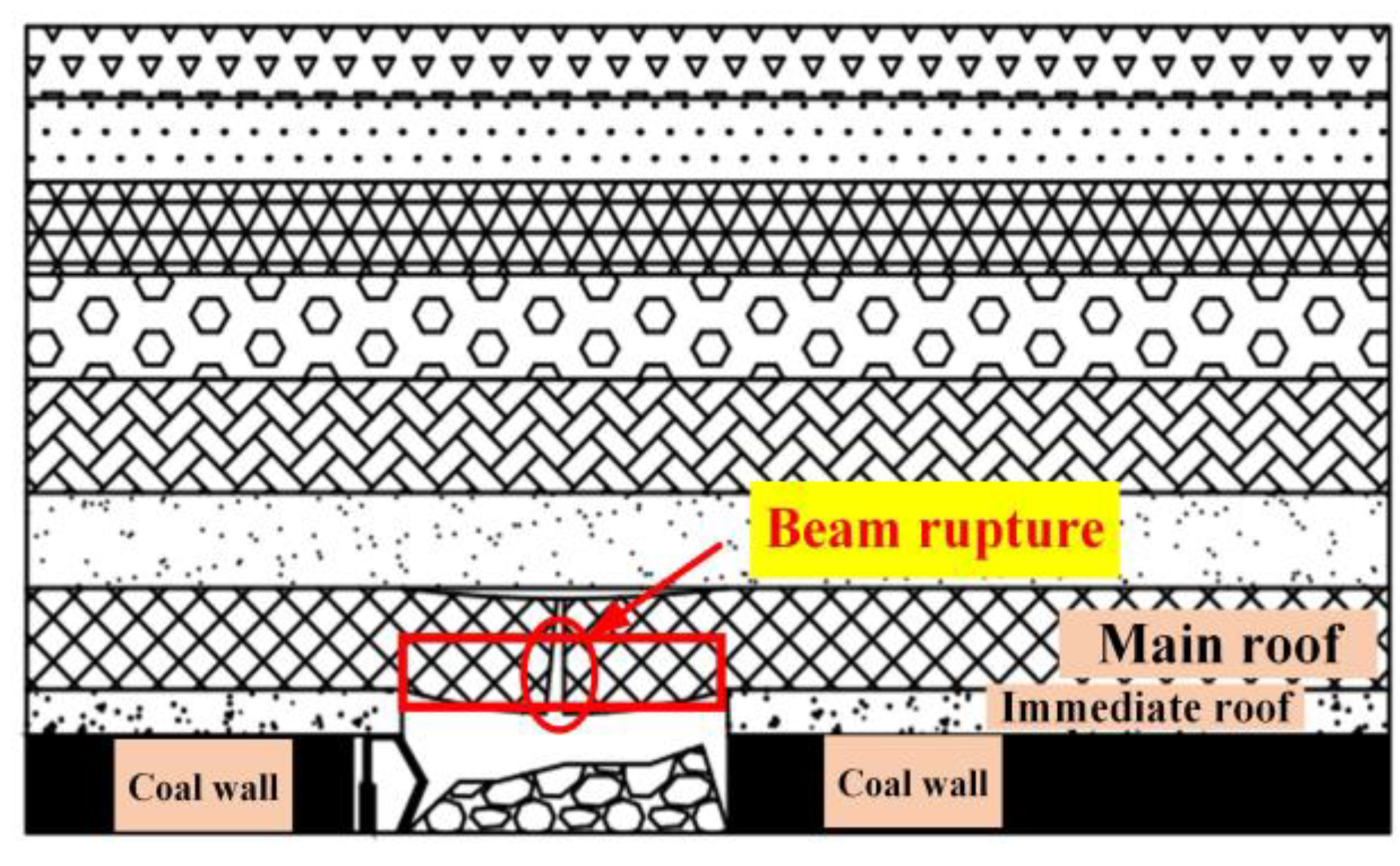
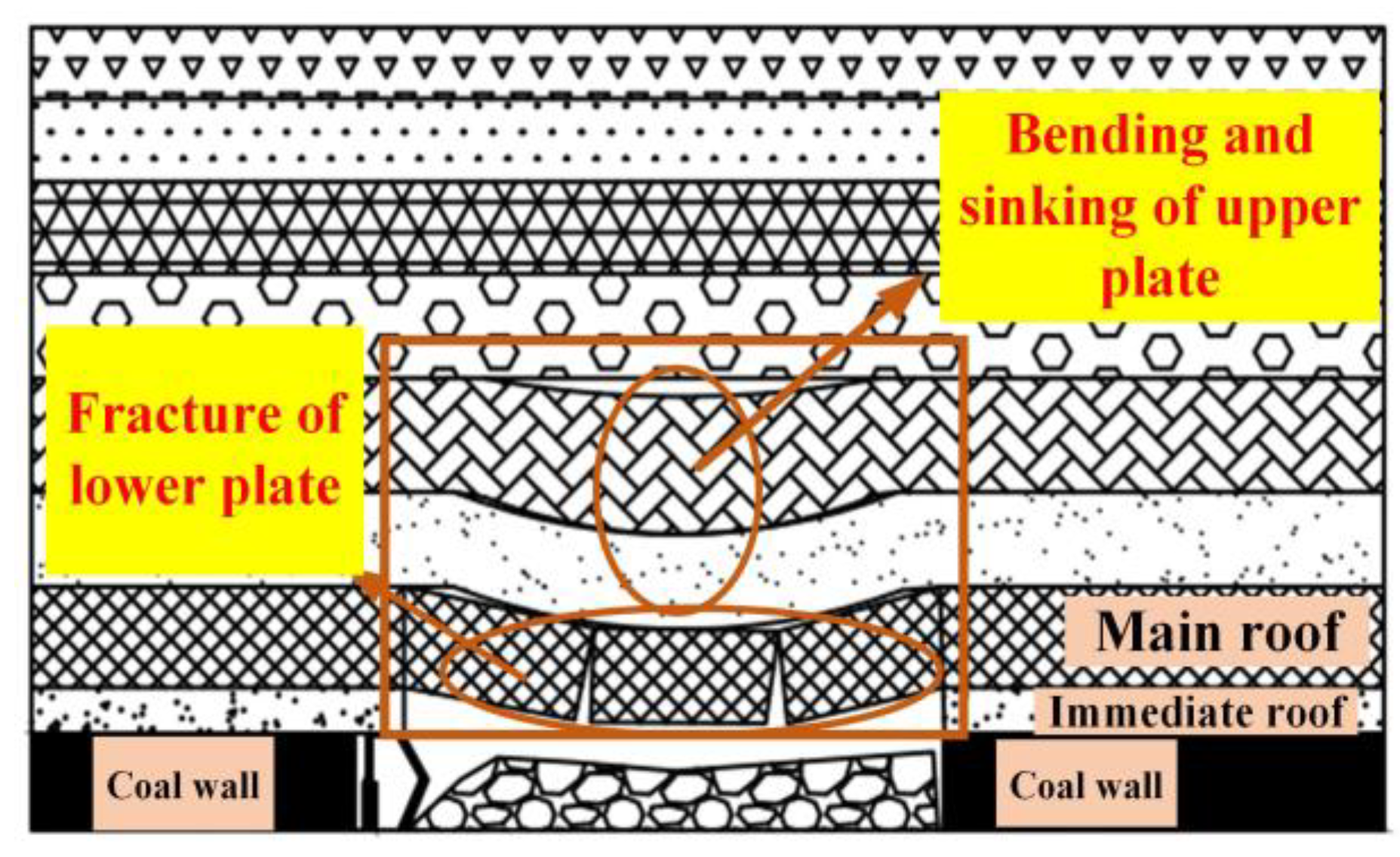

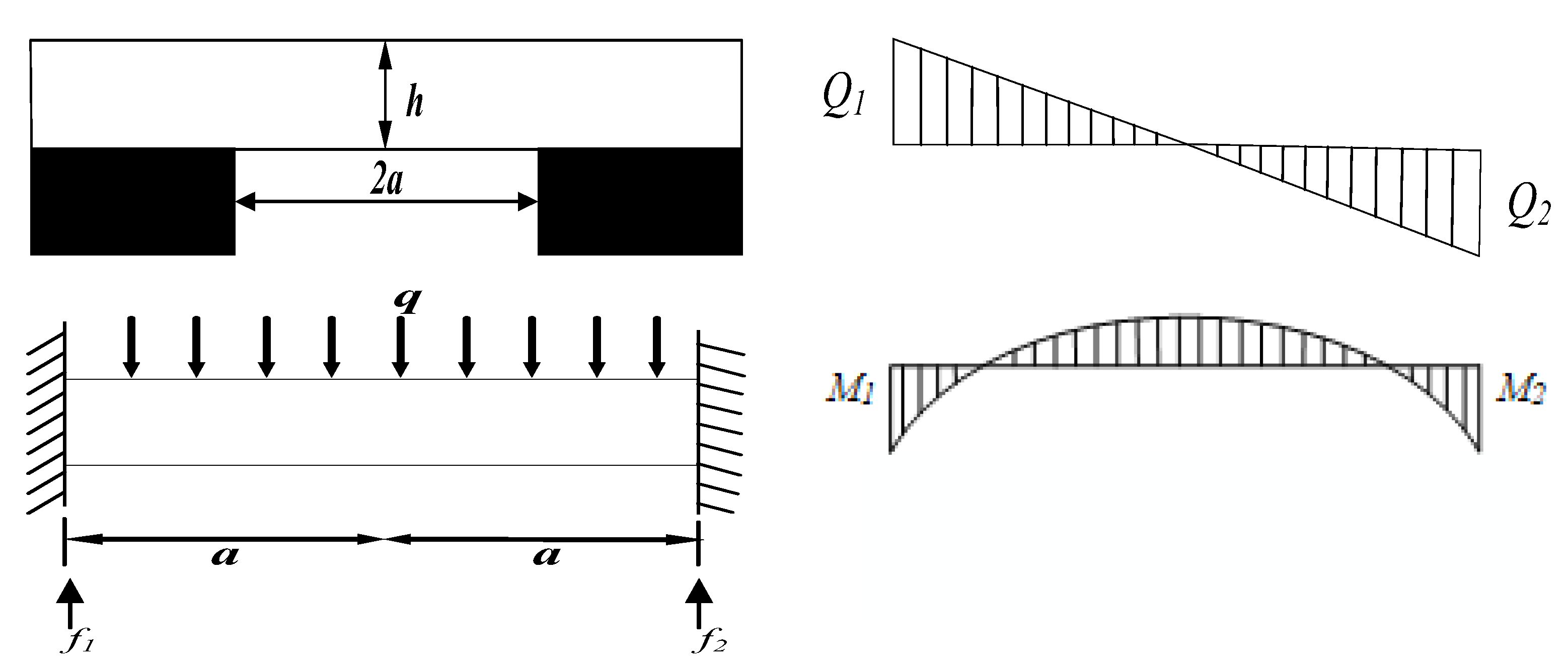

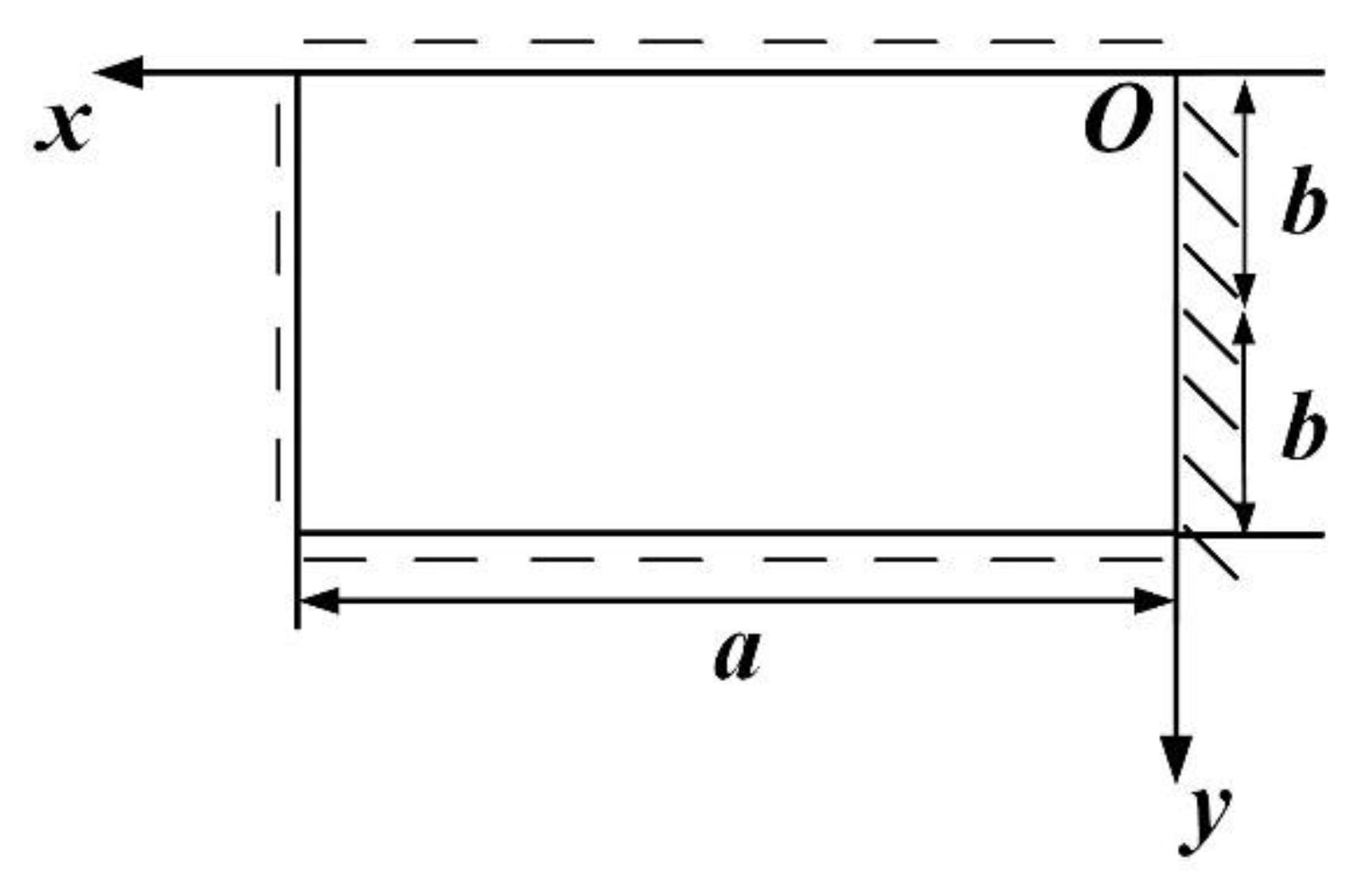
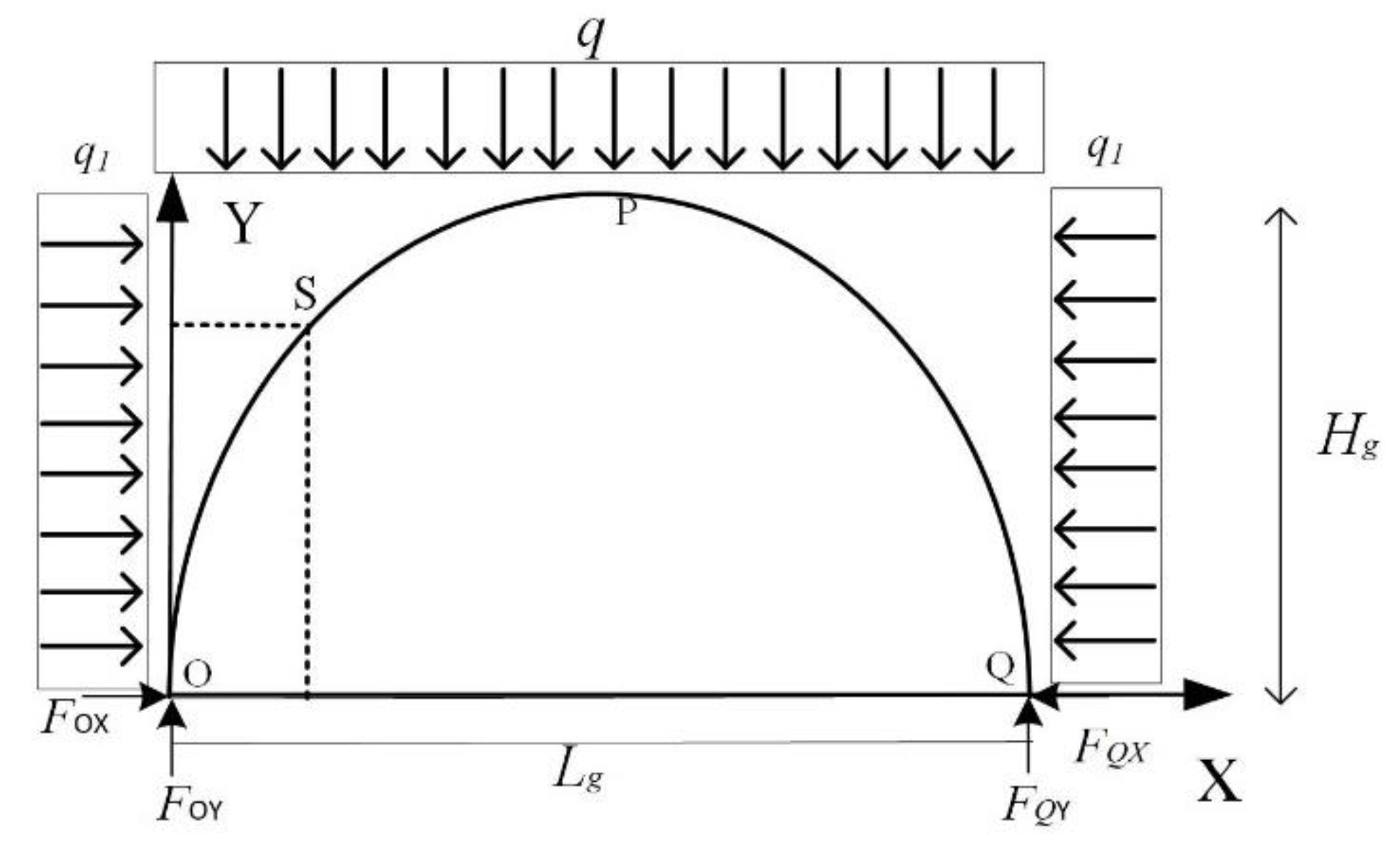


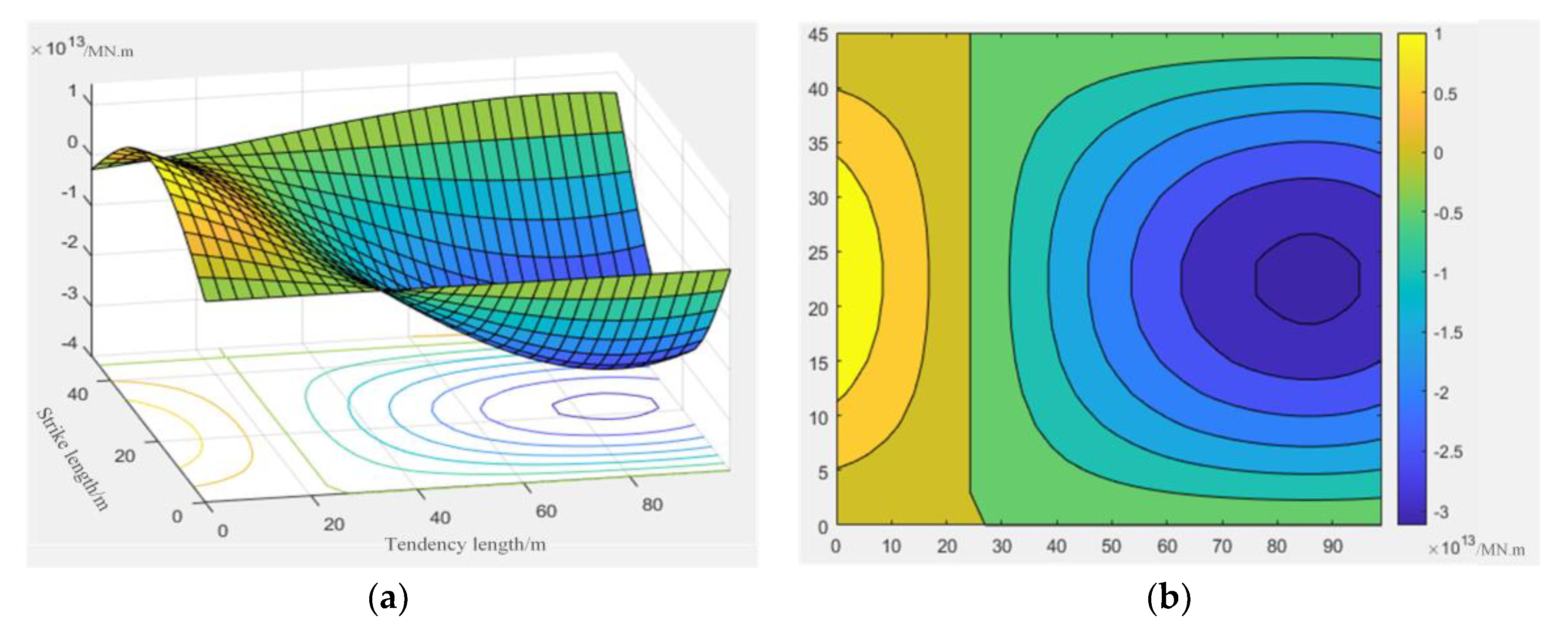
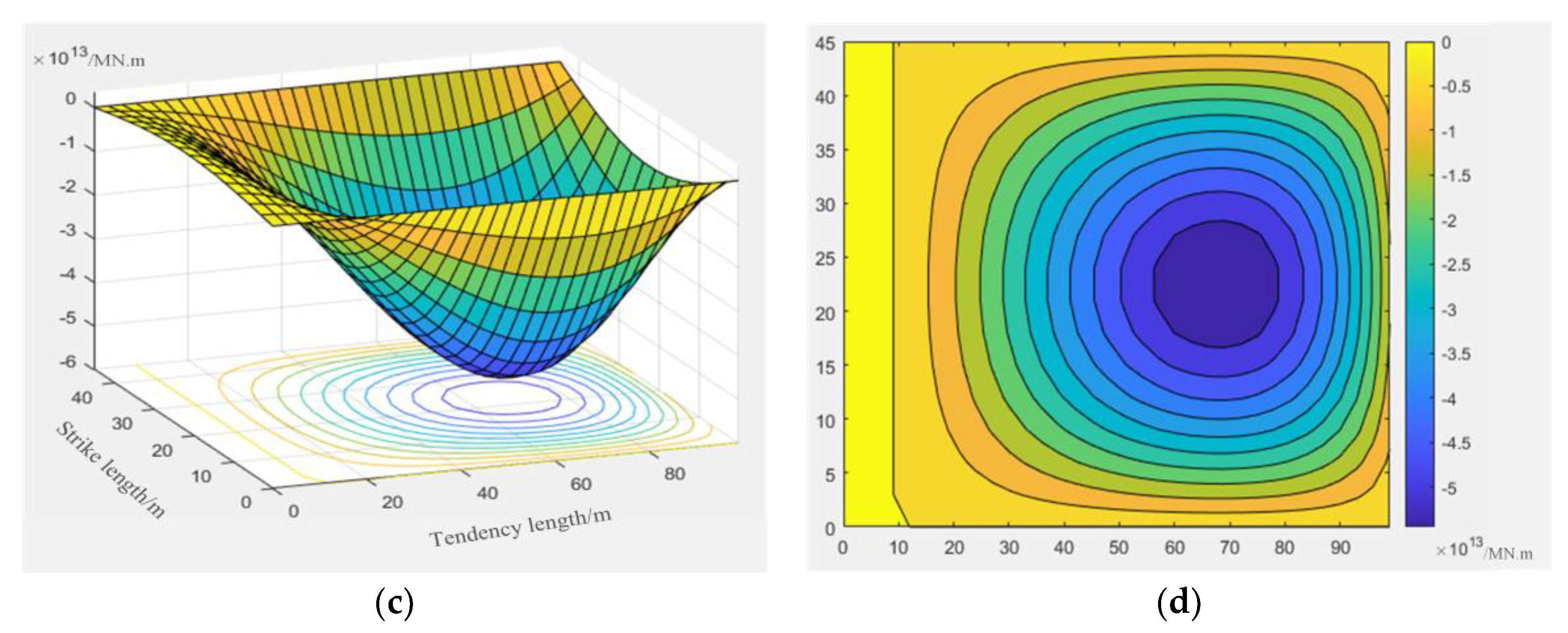



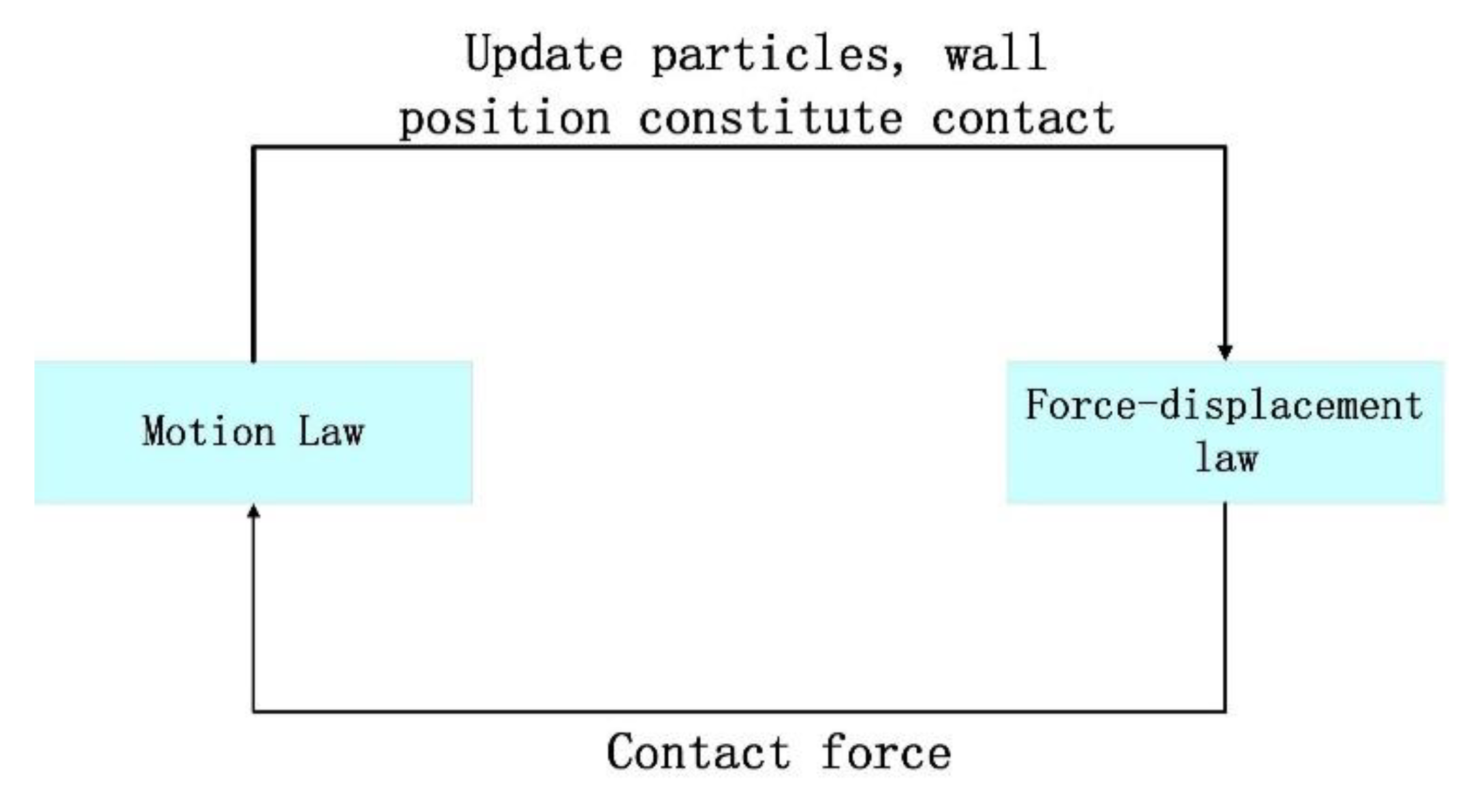


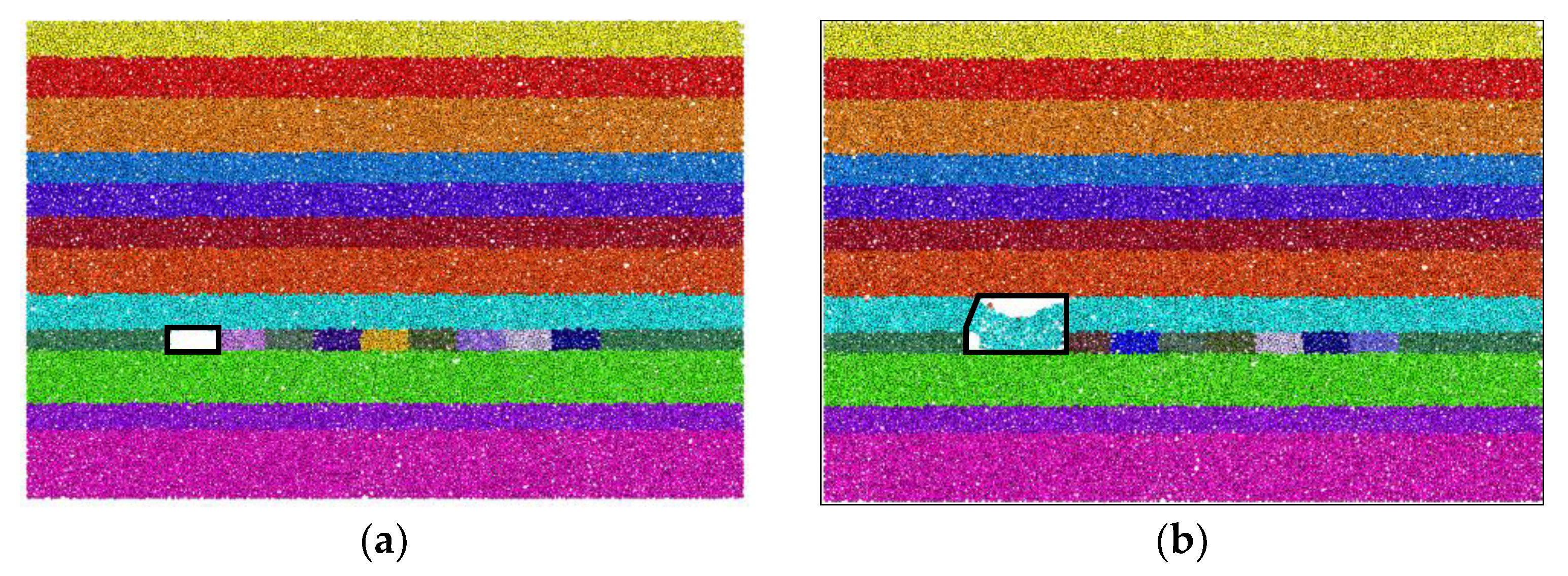
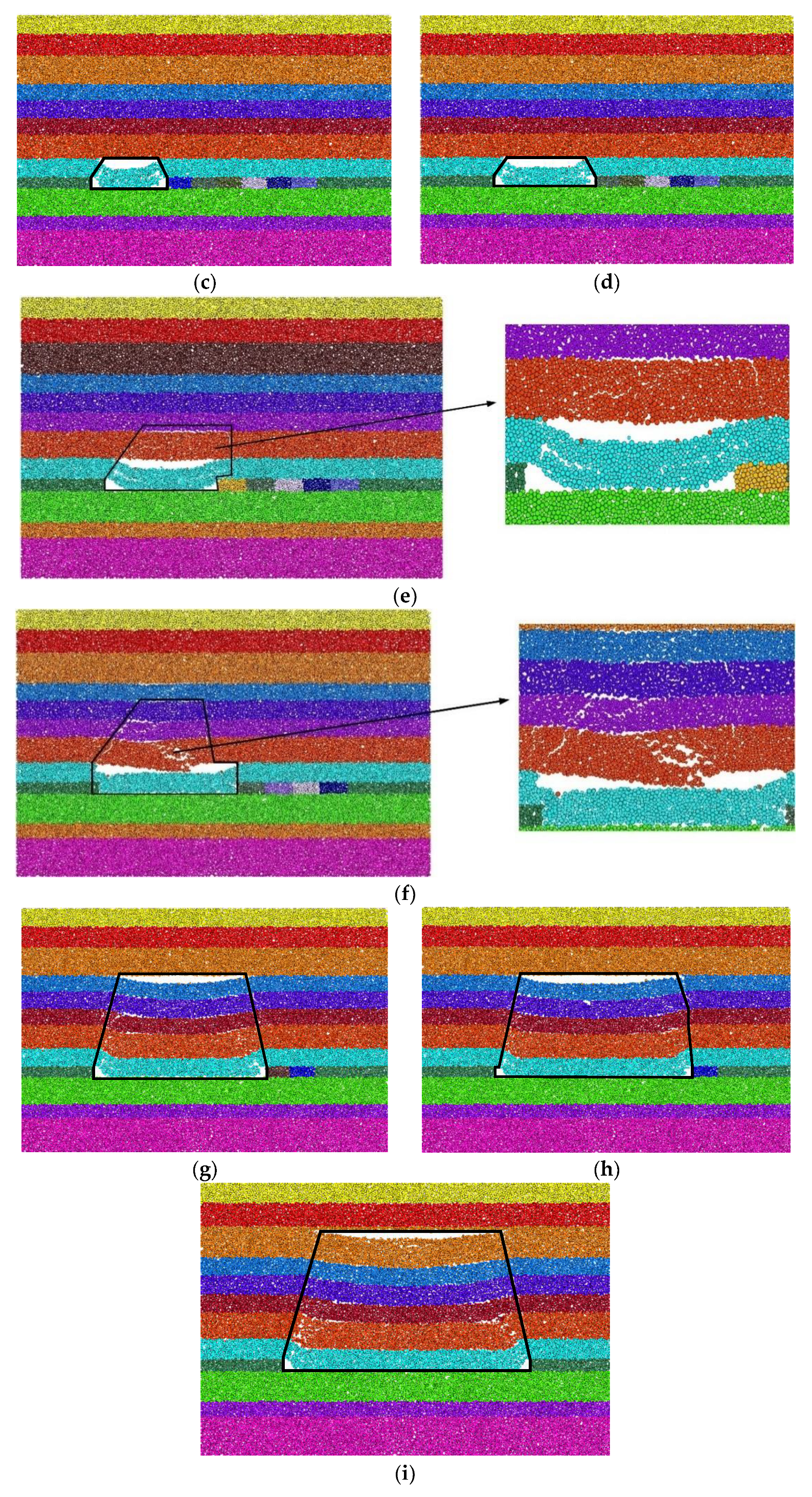
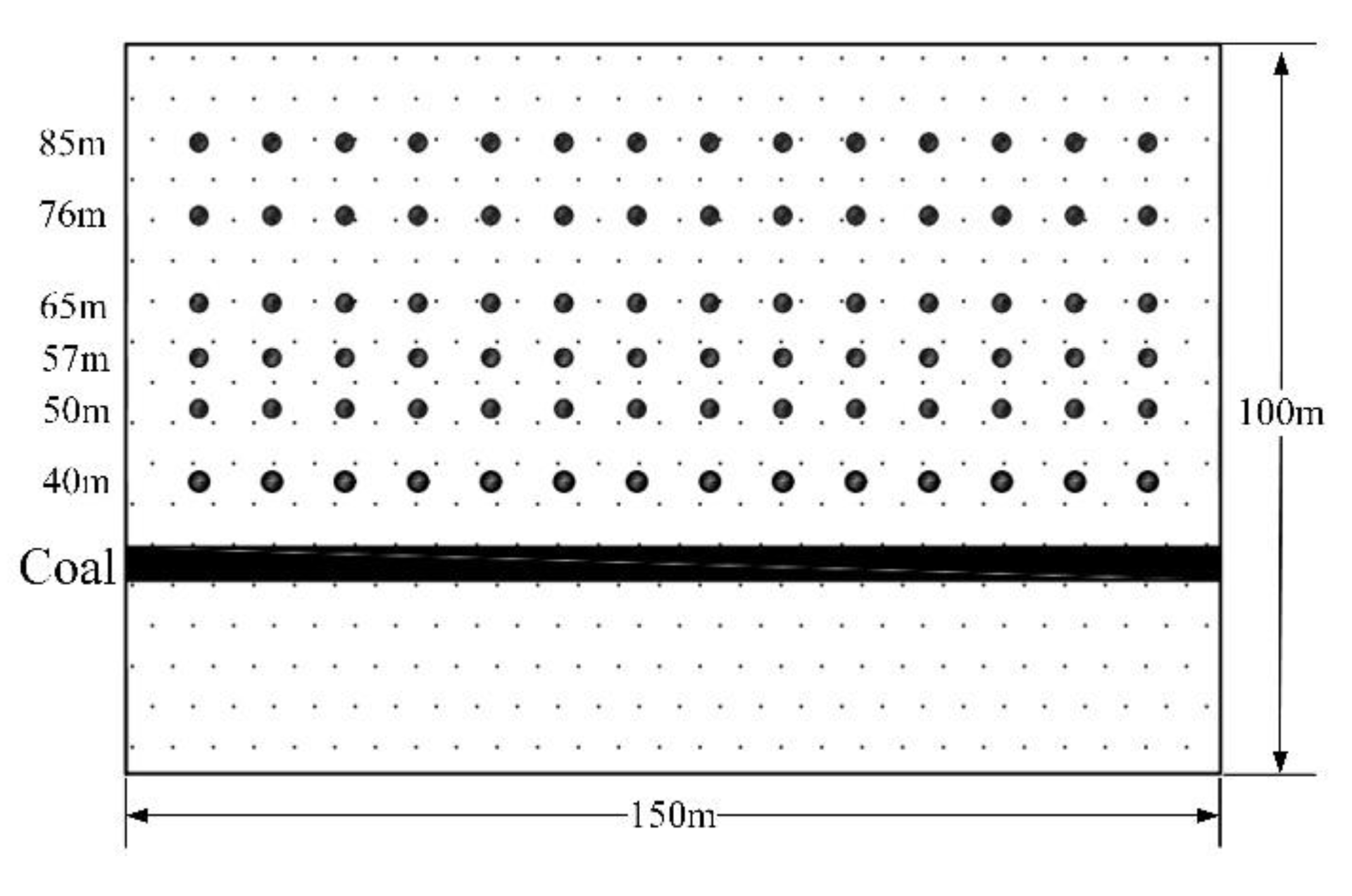

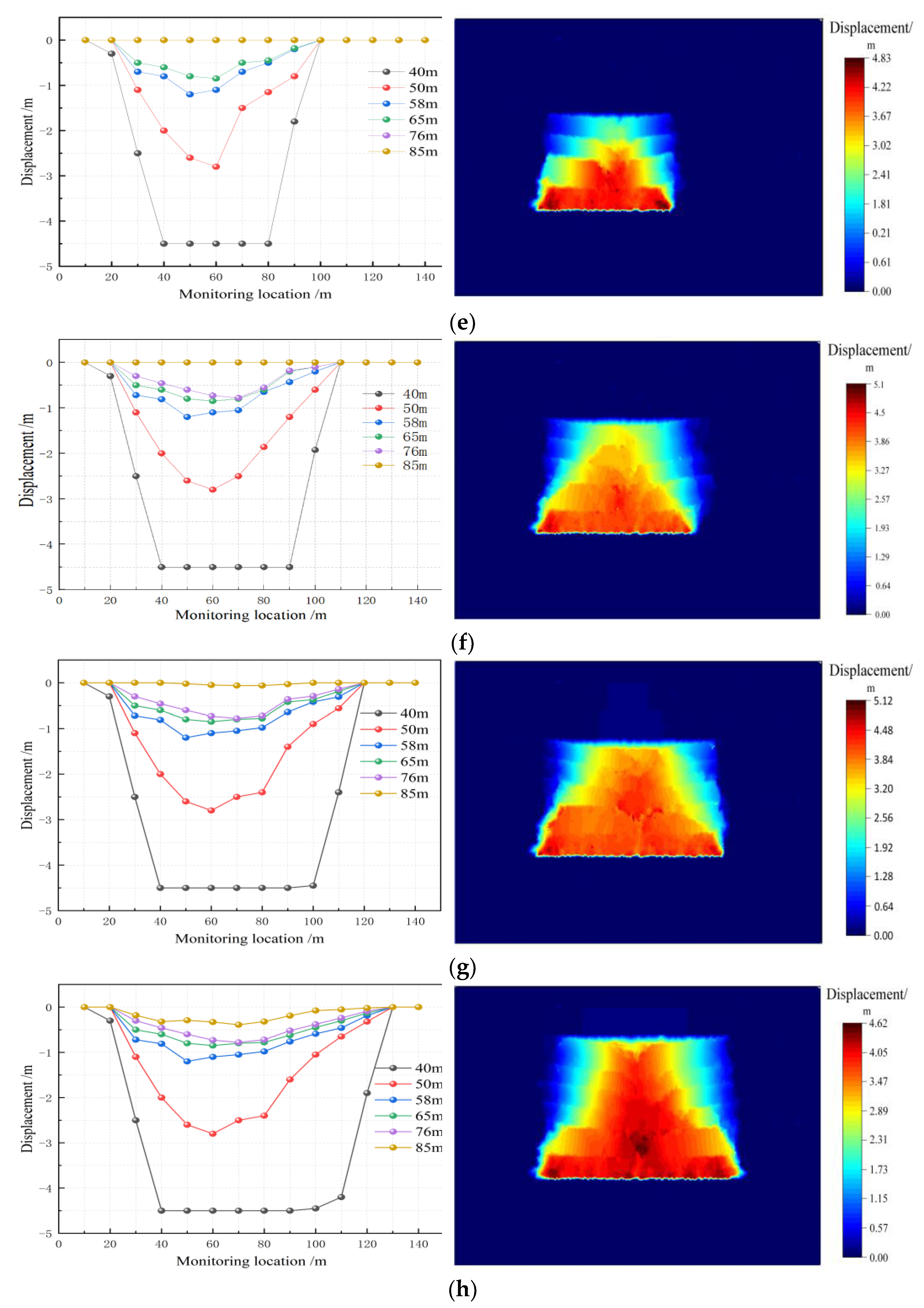


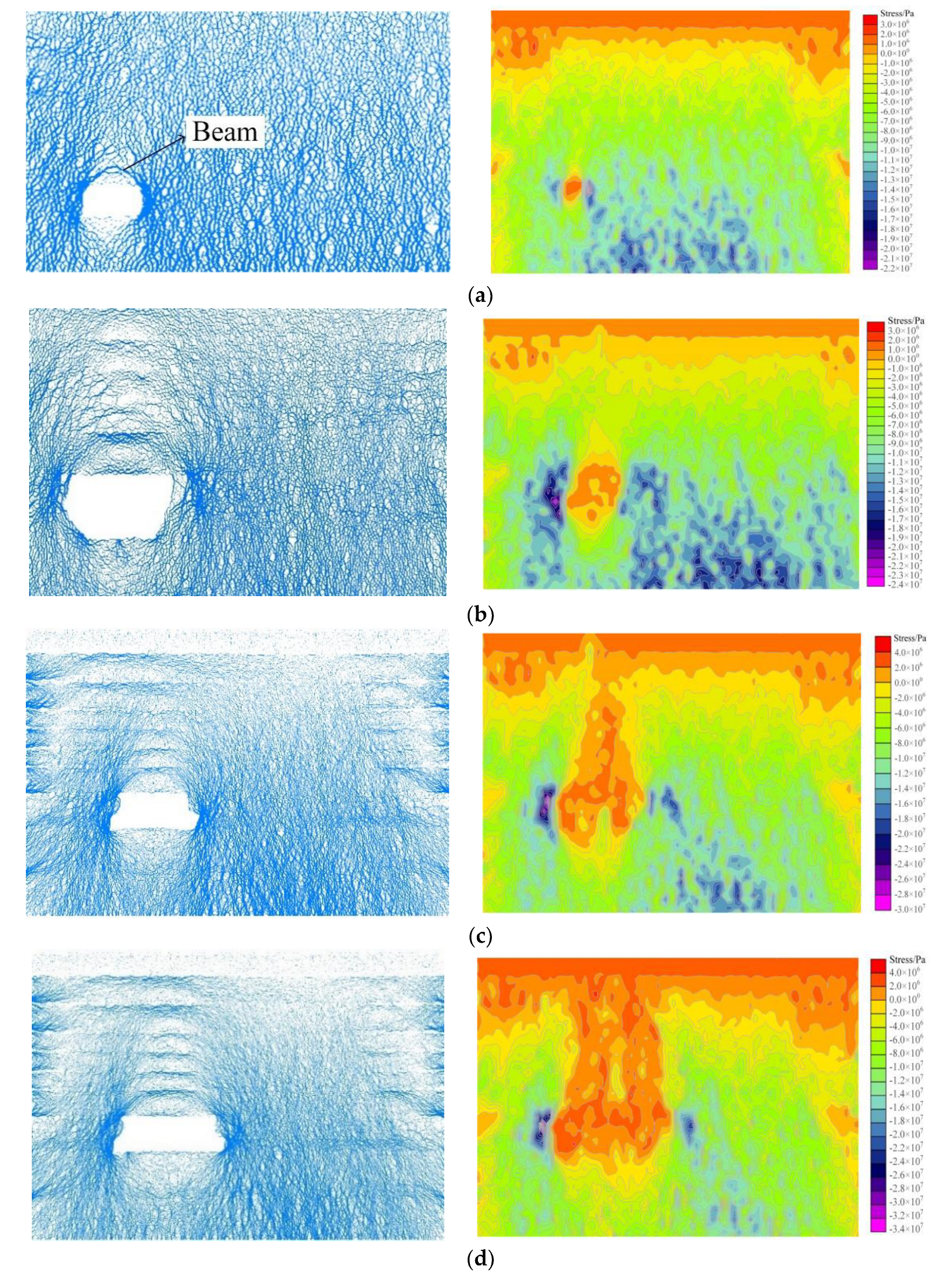
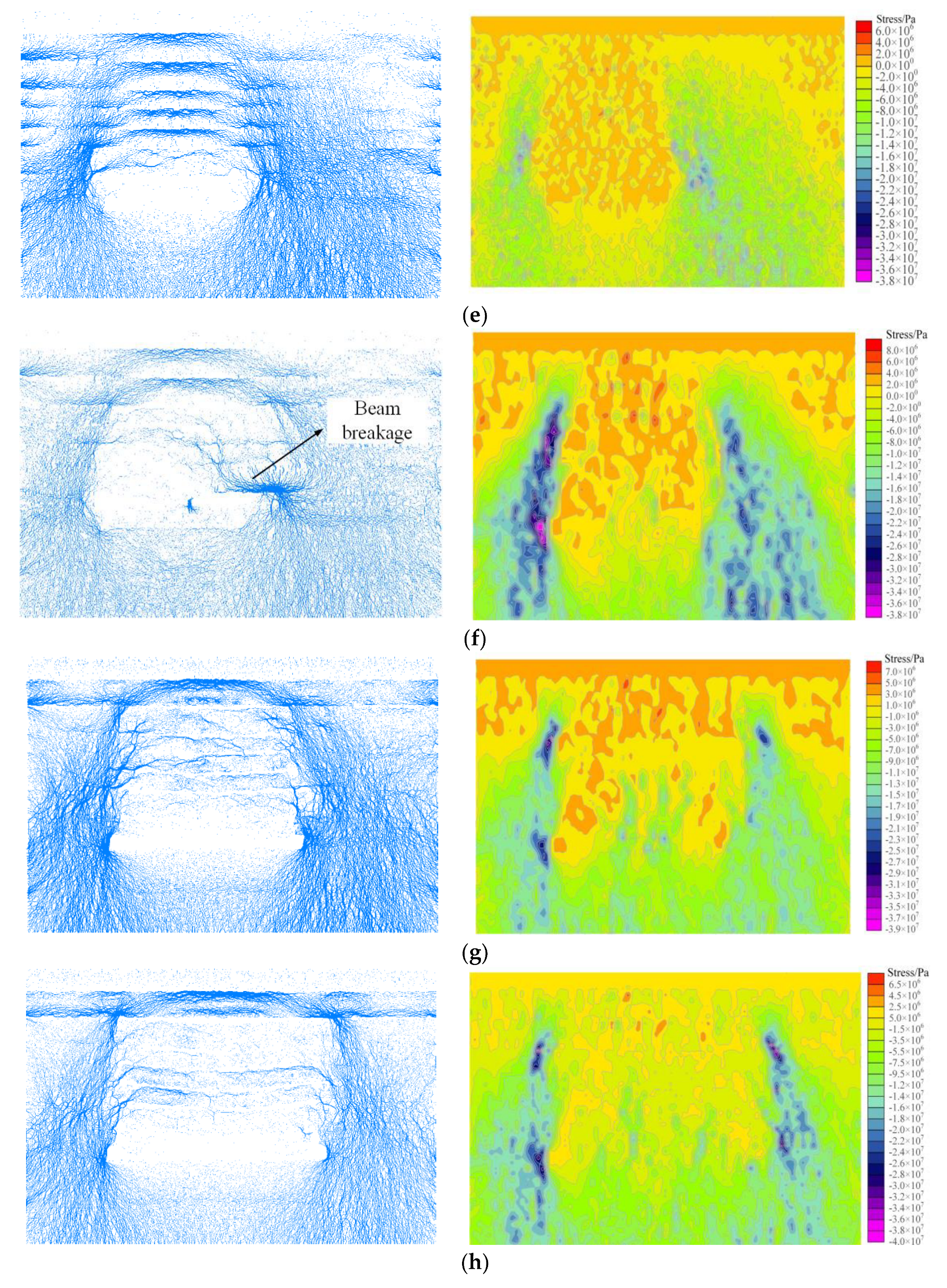
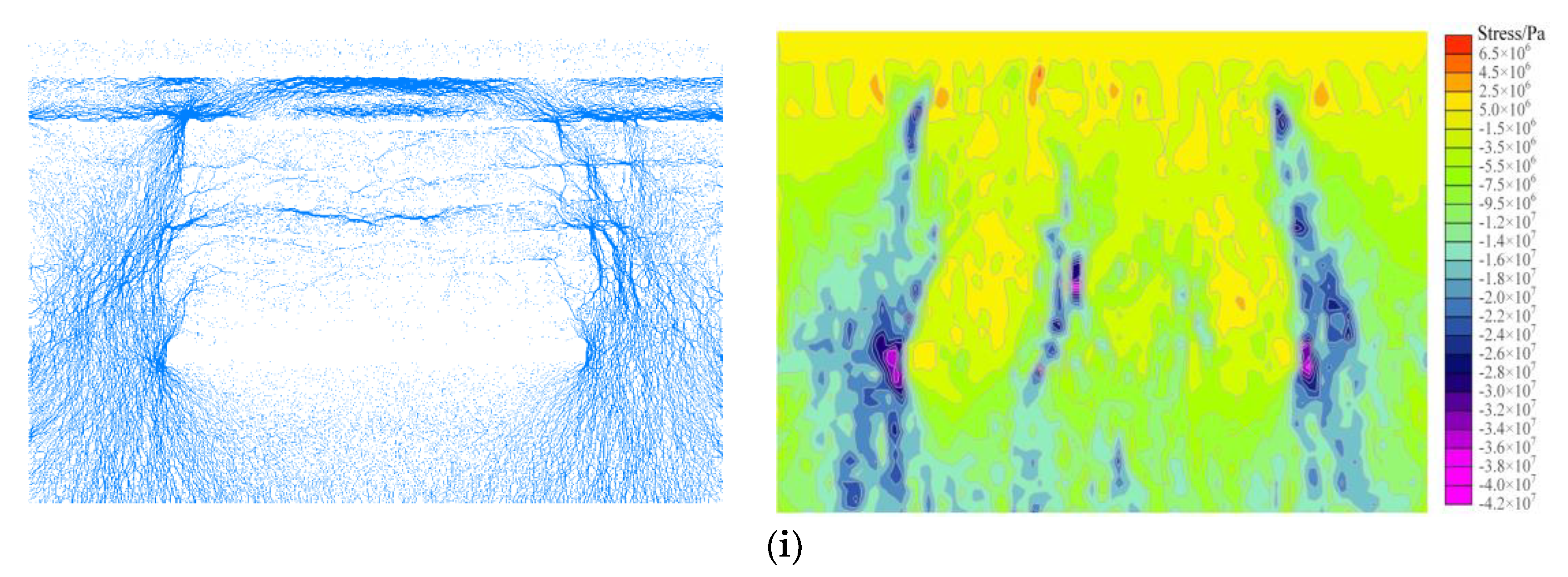
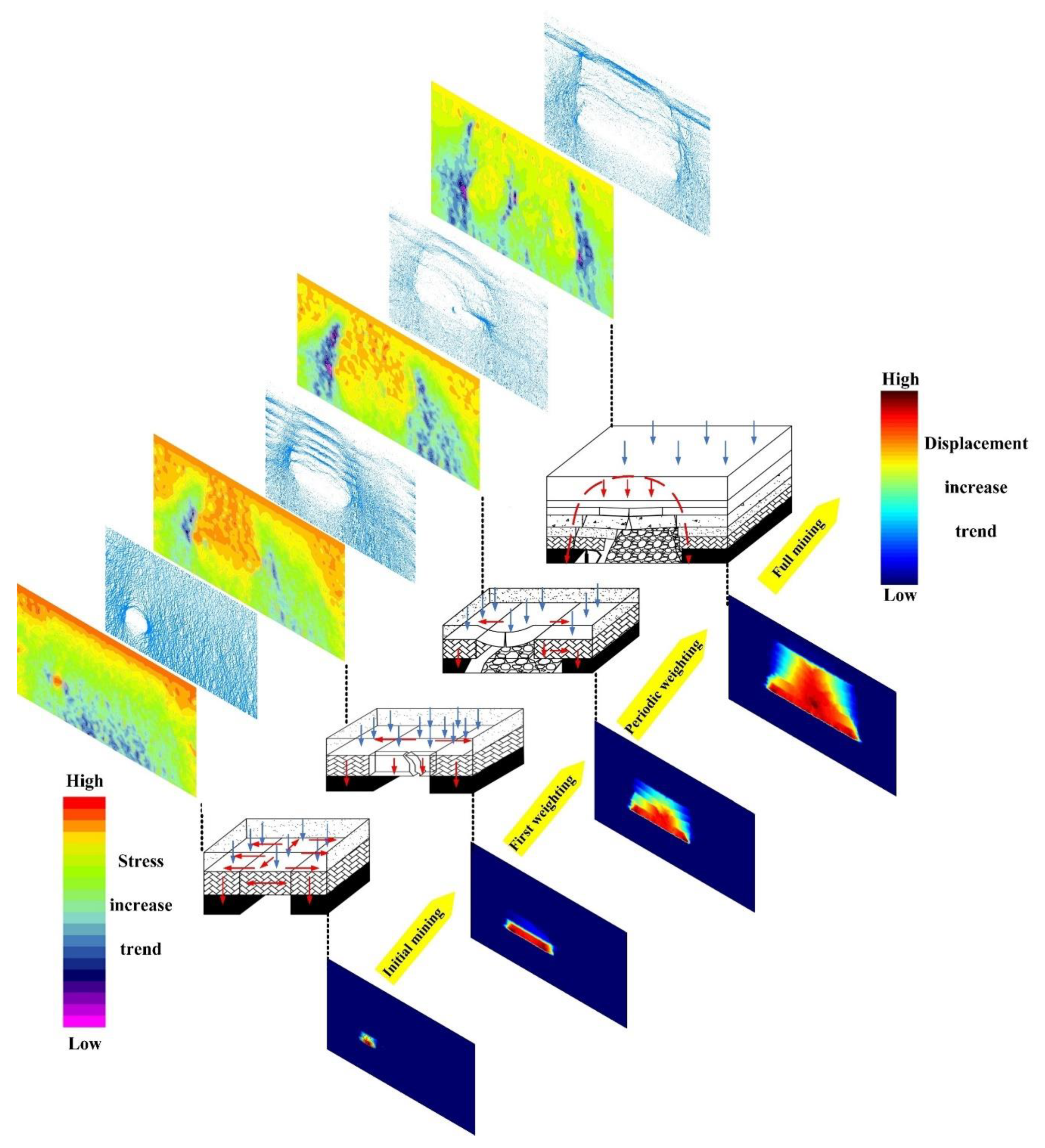
| Roof Name | Rock Name | Thickness (m) | Lithological Characteristics |
|---|---|---|---|
| Main roof | Fine sandstone | 13.8 | Clay cementation, thin layer, rich in mica fragments |
| Immediate roof | sandy mudstone | 8.85 | Clay-based, brittle containing a small amount of plant fossils |
| Lithologic Characters | Elastic Modulus /GPa | Poisson Ratio | Angle of Internal Friction /° | Cohesion /MPa | Density /kg/m3 | Tensile Strength /Mpa |
|---|---|---|---|---|---|---|
| Medium sandstone | 30.05 | 0.29 | 33.90 | 13.35 | 2350 | 3.1 |
| Mudstone | 15.9 | 0.33 | 20.90 | 10.98 | 1860 | 2.5 |
| Fine sandstone | 33.40 | 0.25 | 34.5 | 14.62 | 2500 | 3.2 |
| Mudstone | 15.90 | 0.33 | 20.90 | 10.98 | 1860 | 2.4 |
| Siltstone | 31.20 | 0.31 | 33.40 | 11.61 | 2480 | 4.6 |
| Mudstone | 15.90 | 0.33 | 20.90 | 10.68 | 1860 | 2.1 |
| Fine sandstone | 33.40 | 0.25 | 34.5 | 14.62 | 2500 | 3.1 |
| Sandy mudstone | 3.33 | 0.33 | 22.01 | 4.00 | 1950 | 2.6 |
| 2#Coal | 5.0 | 0.35 | 38.02 | 3.00 | 1360 | 1.6 |
| Mudstone | 15.90 | 0.33 | 20.90 | 10.98 | 1860 | 1.9 |
| Siltstone | 31.20 | 0.31 | 33.40 | 11.61 | 2480 | 3.8 |
| Medium sandstone | 30.05 | 0.29 | 33.90 | 13.35 | 2350 | 2.7 |
| Lithologic Characters | Emod /GPa | Kart | Kn /Gpa | Ks /Gpa | Knpb /Gpa | Kspb /Gpa |
|---|---|---|---|---|---|---|
| Medium sandstone | 28.60 | 2.4 | 51.4 | 21.4 | 49.6 | 20.7 |
| Mudstone | 12.10 | 2.9 | 30.3 | 10.4 | 22.4 | 7.7 |
| Fine sandstone | 26.40 | 1.8 | 56.4 | 31.3 | 45.6 | 25.3 |
| Mudstone | 10.30 | 2.9 | 30.3 | 10.4 | 19.8 | 6.8 |
| Siltstone | 25.60 | 2.6 | 53.1 | 20.4 | 43.6 | 16.8 |
| Mudstone | 8.90 | 2.9 | 30.3 | 10.4 | 18.2 | 6.3 |
| Fine sandstone | 23.60 | 1.8 | 56.4 | 31.3 | 41.6 | 23.1 |
| Sandy mudstone | 2.86 | 1.8 | 11.5 | 6.6 | 7.7 | 4.3 |
| 2#Coal | 4.2 | 3.1 | 14 | 4.5 | 9.7 | 3.1 |
| Mudstone | 8.2 | 2.9 | 30.3 | 10.4 | 16.4 | 5.7 |
| Siltstone | 21.20 | 2.6 | 53.1 | 20.4 | 39.7 | 15.3 |
| Medium sandstone | 26.05 | 2.4 | 51.4 | 21.4 | 44.9 | 18.8 |
Disclaimer/Publisher’s Note: The statements, opinions and data contained in all publications are solely those of the individual author(s) and contributor(s) and not of MDPI and/or the editor(s). MDPI and/or the editor(s) disclaim responsibility for any injury to people or property resulting from any ideas, methods, instructions or products referred to in the content. |
© 2023 by the authors. Licensee MDPI, Basel, Switzerland. This article is an open access article distributed under the terms and conditions of the Creative Commons Attribution (CC BY) license (https://creativecommons.org/licenses/by/4.0/).
Share and Cite
Wang, X.; Zhang, Q.; Liu, W.; Wei, Y.; Jiang, T.; Hao, F. Study on Space–Time Evolution Law and Mechanism of Instability Failure of Deep High-Stress Overburden Rock. Appl. Sci. 2023, 13, 4573. https://doi.org/10.3390/app13074573
Wang X, Zhang Q, Liu W, Wei Y, Jiang T, Hao F. Study on Space–Time Evolution Law and Mechanism of Instability Failure of Deep High-Stress Overburden Rock. Applied Sciences. 2023; 13(7):4573. https://doi.org/10.3390/app13074573
Chicago/Turabian StyleWang, Xinfeng, Qiao Zhang, Wengang Liu, Youyu Wei, Tian Jiang, and Fuxu Hao. 2023. "Study on Space–Time Evolution Law and Mechanism of Instability Failure of Deep High-Stress Overburden Rock" Applied Sciences 13, no. 7: 4573. https://doi.org/10.3390/app13074573






